Alpine Wall on:
[Wikipedia]
[Google]
[Amazon]
The Alpine Wall (''Vallo Alpino'') was an Italian system of fortifications along the of
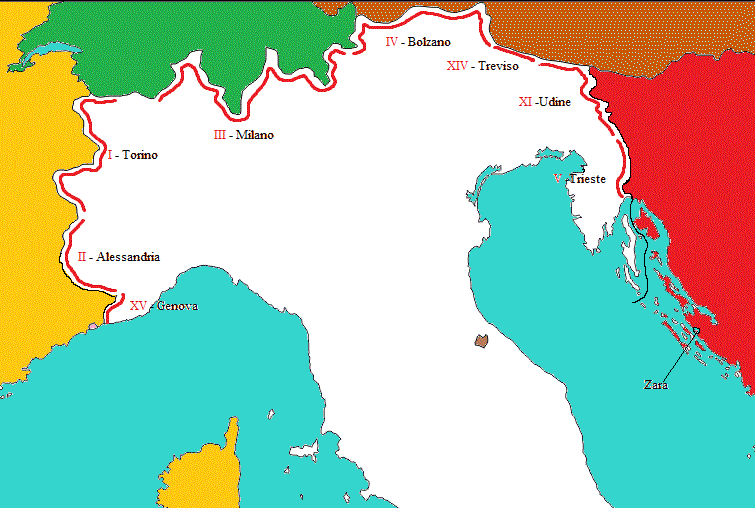 The Alpine line was similar in concept to other fortifications of the same era, including the
The Alpine line was similar in concept to other fortifications of the same era, including the

 Work on the Alpine Wall began in 1931, intended to cover an arc from the
Work on the Alpine Wall began in 1931, intended to cover an arc from the
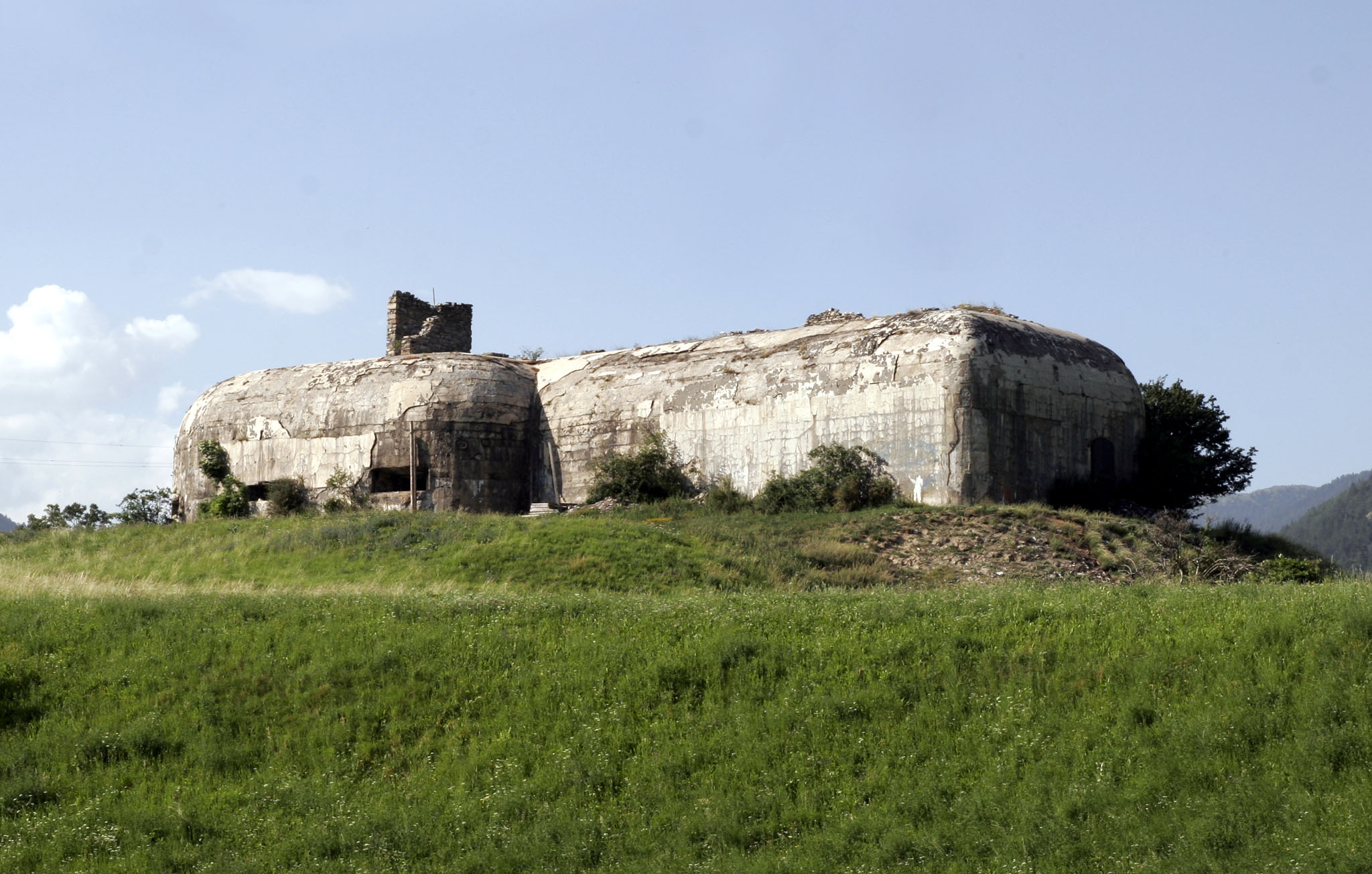
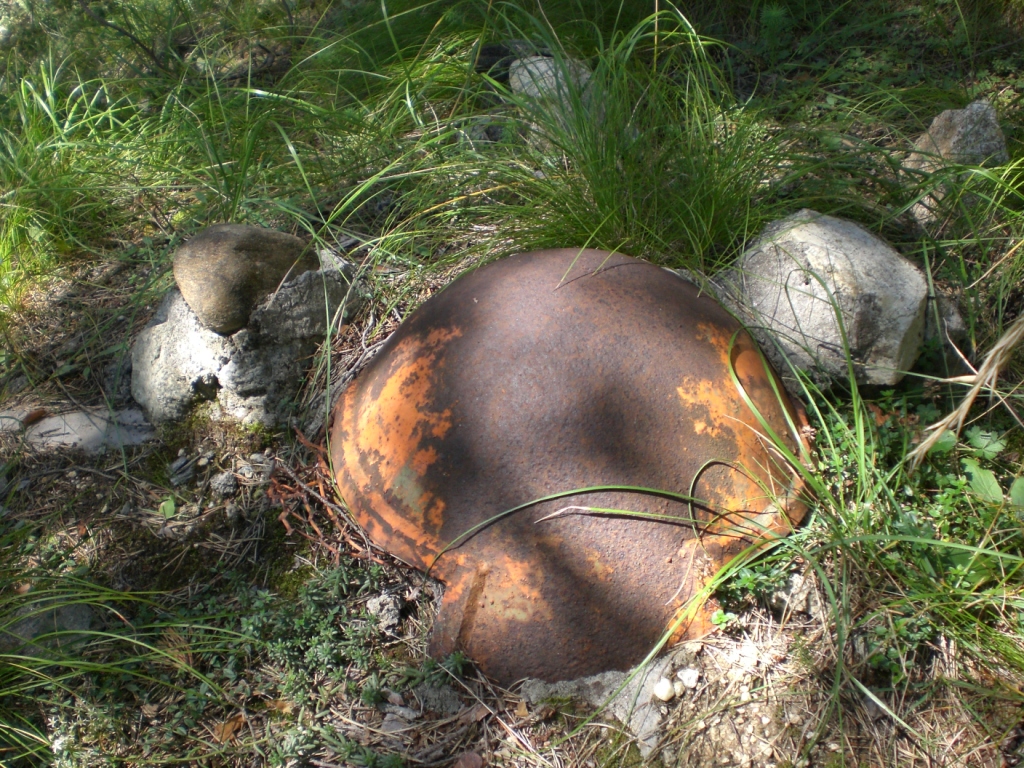
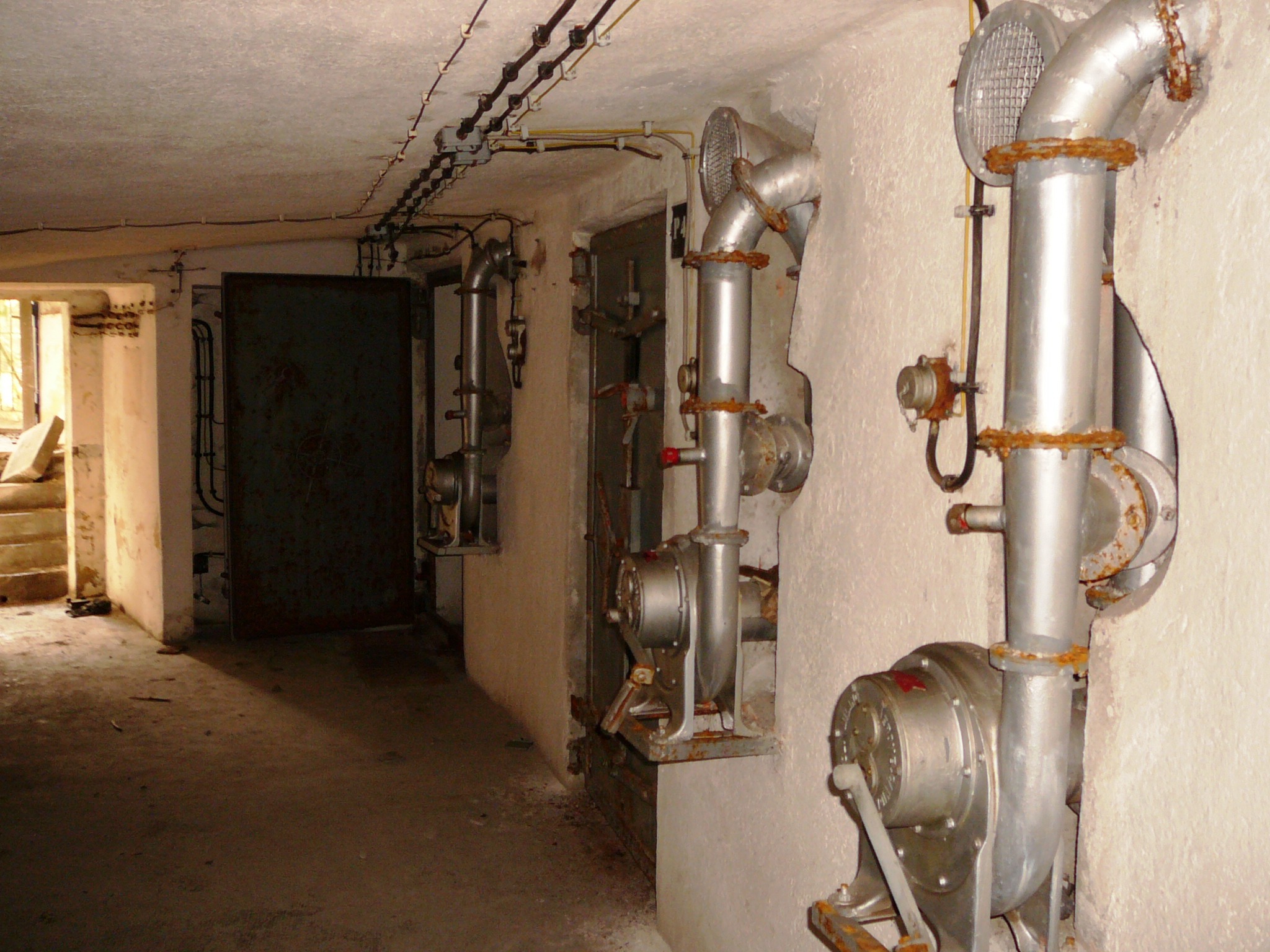
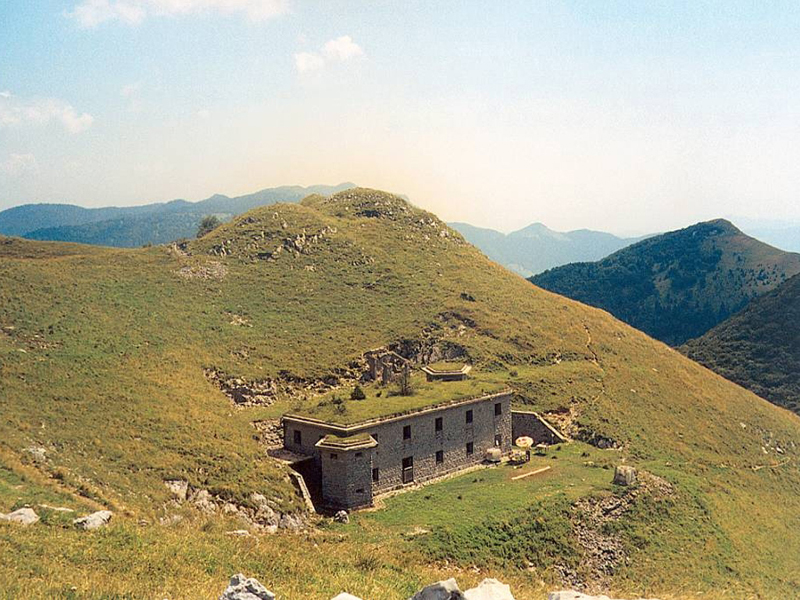 The fortifications were primarily constructed in the flanking heights of the valleys, with works within the valleys only where they were sufficiently wide. Anti-tank guns, artillery and machine guns were trained on prepared fields of fire, with observation stations at higher points. Shelters for infantry were located rearwards. A system of communications links and roads, or for higher locations, ropeways were provided for communication and supply.
The fortifications were primarily constructed in the flanking heights of the valleys, with works within the valleys only where they were sufficiently wide. Anti-tank guns, artillery and machine guns were trained on prepared fields of fire, with observation stations at higher points. Shelters for infantry were located rearwards. A system of communications links and roads, or for higher locations, ropeways were provided for communication and supply.
History of the "Guardia alla Frontiera" (in Italian)
/ref> They defended the of northern Italian frontiers with the so-called "Vallo Alpino Occidentale" ( with
Blu Edizioni
Torino 2005, *Kauffmann, J.E., Jurga, Robert M. ''Fortress Europe: European Fortifications of World War II'', 1999. * Alessandro Bernasconi; Giovanni Muran. ''Le fortificazioni del Vallo Alpino Littorio in Alto Adige'' Trento, editore Temi
The Underground Fortifications of the Alpine WallLe fortificazioni del Vallo Alpino in provincia di Cuneo
* http://www.vecio.it
Vallo alpino del Littorio nelle attuali Slovenia e Croazia (1920-1943)
{{Authority control World War II defensive lines Italian fascist architecture World War II sites in Italy Yugoslavia in World War II World War II sites in Slovenia National redoubts
Italy
Italy ( it, Italia ), officially the Italian Republic, ) or the Republic of Italy, is a country in Southern Europe. It is located in the middle of the Mediterranean Sea, and its territory largely coincides with the homonymous geographical ...
's northern frontier. Built in the years leading up to World War II
World War II or the Second World War, often abbreviated as WWII or WW2, was a world war that lasted from 1939 to 1945. It involved the World War II by country, vast majority of the world's countries—including all of the great power ...
at the direction of Italian dictator Benito Mussolini, the defensive line faced France
France (), officially the French Republic ( ), is a country primarily located in Western Europe. It also comprises of overseas regions and territories in the Americas and the Atlantic, Pacific and Indian Oceans. Its metropolitan ar ...
, Switzerland, Austria
Austria, , bar, Östareich officially the Republic of Austria, is a country in the southern part of Central Europe, lying in the Eastern Alps. It is a federation of nine states, one of which is the capital, Vienna, the most populous ...
, and Yugoslavia
Yugoslavia (; sh-Latn-Cyrl, separator=" / ", Jugoslavija, Југославија ; sl, Jugoslavija ; mk, Југославија ;; rup, Iugoslavia; hu, Jugoszlávia; rue, label= Pannonian Rusyn, Югославия, translit=Juhoslavij ...
. It was defended by the " Guardia alla Frontiera" (GaF), Italian special troops.
Characteristics
 The Alpine line was similar in concept to other fortifications of the same era, including the
The Alpine line was similar in concept to other fortifications of the same era, including the Maginot Line
The Maginot Line (french: Ligne Maginot, ), named after the French Minister of War André Maginot, is a line of concrete fortifications, obstacles and weapon installations built by France in the 1930s to deter invasion by Germany and force the ...
of France, the Siegfried Line
The Siegfried Line, known in German as the ''Westwall'', was a German defensive line built during the 1930s (started 1936) opposite the French Maginot Line. It stretched more than ; from Kleve on the border with the Netherlands, along the we ...
of Germany, and the National Redoubt of Switzerland.
Italy's land frontiers were in most places mountainous and easily defended, but in the years leading up to World War II, Italy's relations with its neighbours were uneasy. Even in its dealings with its German ally, Italy was concerned about German ambitions towards the province of South Tyrol, inhabited by a German majority.
Due to the rugged nature of the Alpine frontier, defences were confined to passes and observation posts in accessible locations.
History
Mediterranean
The Mediterranean Sea is a sea connected to the Atlantic Ocean, surrounded by the Mediterranean Basin and almost completely enclosed by land: on the north by Western and Southern Europe and Anatolia, on the south by North Africa, and on th ...
coast at Ventimiglia
Ventimiglia (; lij, label= Intemelio, Ventemiglia , lij, label=Genoese, Vintimiggia; french: Vintimille ; oc, label=Provençal, Ventemilha ) is a resort town in the province of Imperia, Liguria, northern Italy. It is located southwest of ...
in the west to Fiume on the Adriatic coast in the east. Three zones were designated at increasing distances from the frontier:
* "Zone of Security": Initial contact with the enemy.
* "Zone of Resistance": Heavier fortifications capable of resistance in isolation.
* "Zone of Alignment": Assembly area for counterattack, into which the enemy was to be directed.
Three types of fortifications were provided:
* "Type A": The largest fortifications, generally built into mountainsides.
* "Type B": Smaller point-defence fortifications.
* "Type C": Widely distributed shelters and rallying points
The work, which was carried out in secrecy using Italian labor, was a significant economic burden, resulting in 208 installations with 647 machine guns and fifty artillery pieces. Construction continued until 1942; a report by General Vittorio Ambrosio on 3 October 1942 recorded that 1,475 bunkers had been completed and 450 more were under construction. The forts were armed with a mixture of new weaponry and older equipment from World War I
World War I (28 July 1914 11 November 1918), often abbreviated as WWI, was List of wars and anthropogenic disasters by death toll, one of the deadliest global conflicts in history. Belligerents included much of Europe, the Russian Empire, ...
. Provisions were made to deal with the use of poison gas. Much of the armour was obtained from Germany in compensation for Italian military ventures on behalf of the Axis.
The Alpine Wall during World War II
Little use was made of the Alpine Wall duringWorld War II
World War II or the Second World War, often abbreviated as WWII or WW2, was a world war that lasted from 1939 to 1945. It involved the World War II by country, vast majority of the world's countries—including all of the great power ...
. During the Italian invasion of France in 1940, some western forts such as Fort Chaberton exchanged fire with their French counterparts of the Alpine Line. Chaberton was hit by French 280mm field mortars and suffered disabling damage. In addition, some Alpine Wall fortifications were used defensively by the Germans in 1944.
After World War II
At the end of the conflict, some of the western fortifications were destroyed. In the east former Austro-Hungarian territories that Italy acquired with the London treaty of 1915 were in 1947 awarded to Yugoslavia. Consequently, the entire eastern part of the pre-WW2 fortifications were thus on the Yugoslav side and are now on Slovenian territory. The 1947 Paris Peace Treaty forbade the construction or expansion of fortifications within twenty kilometers of the border. However, with Italy's membership inNATO
The North Atlantic Treaty Organization (NATO, ; french: Organisation du traité de l'Atlantique nord, ), also called the North Atlantic Alliance, is an intergovernmental military alliance between 30 member states – 28 European and two No ...
, construction began on a new defensive line from Austria to the Adriatic along the Yugoslavian border along the Natisone and Tagliamento rivers. The new line used tank turrets in a manner similar to German defences during the previous conflict, allowing 360 degree traverse and a high rate of fire. By 1976 this system was still considered useful in any conflict short of nuclear war.
Abandonment
The end of the Cold War brought an end to the usefulness of the Alpine Wall. The emplacements were partially stripped and sealed in 1991-1992. Only some active fortifications have been preserved.Arrangement


 The fortifications were primarily constructed in the flanking heights of the valleys, with works within the valleys only where they were sufficiently wide. Anti-tank guns, artillery and machine guns were trained on prepared fields of fire, with observation stations at higher points. Shelters for infantry were located rearwards. A system of communications links and roads, or for higher locations, ropeways were provided for communication and supply.
The fortifications were primarily constructed in the flanking heights of the valleys, with works within the valleys only where they were sufficiently wide. Anti-tank guns, artillery and machine guns were trained on prepared fields of fire, with observation stations at higher points. Shelters for infantry were located rearwards. A system of communications links and roads, or for higher locations, ropeways were provided for communication and supply.
Fortifications
The individual fortifications were typically built in rock on valley sides. Where this was not suitable, concrete was used for protection, with a minimum of openings and three to five metres of concrete thickness. Combat blocks were to the front, with ammunition rooms behind. Underground galleries connected the combat blocks and their support areas, such as the utility rooms, barracks, storage and command centres, with the main entry farthest to the rear. Combat areas were isolated from the rest of the structure by gas-tight doorways. Units built after 1939 were designed to operate independently, cut off from utilities and supplies. Fortifications werecamouflage
Camouflage is the use of any combination of materials, coloration, or illumination for concealment, either by making animals or objects hard to see, or by disguising them as something else. Examples include the leopard's spotted coat, the b ...
d so that they appeared to blend with the surroundings, whether doors or embrasures were open or closed. Emergency escape routes were also provided.
Armament
Armament typically included an anti-tank gun and a number of machine guns. Post-war units used tank turrets. Usual armament included: * Machine gun, Fiat 35 in casemate or metal turret * Machine gun, Breda 30 and Breda M37, for defense of entries to the fortifications * Gun 57/43 RM mod. 887 on naval mounts * Gun 75/43, ball mount in 10 cm steel slab * Gun 47/32 * Mortar 81mm mod. 35 * Flamethrower Fortifications were usually surrounded by minefields andbarbed wire
A close-up view of a barbed wire
Roll of modern agricultural barbed wire
Barbed wire, also known as barb wire, is a type of steel fencing wire constructed with sharp edges or points arranged at intervals along the strands. Its primary use is ...
. Where feasible, an anti-tank ditch was provided.
Guardia alla Frontiera
The Vallo Alpino was mainly defended by the 21,000 strong " Guardia alla Frontiera" (G.A.F.), a special Italian corps created in 1937./ref> They defended the of northern Italian frontiers with the so-called "Vallo Alpino Occidentale" ( with
France
France (), officially the French Republic ( ), is a country primarily located in Western Europe. It also comprises of overseas regions and territories in the Americas and the Atlantic, Pacific and Indian Oceans. Its metropolitan ar ...
), "Vallo Alpino Settentrionale" ( with Switzerland and with Austria
Austria, , bar, Östareich officially the Republic of Austria, is a country in the southern part of Central Europe, lying in the Eastern Alps. It is a federation of nine states, one of which is the capital, Vienna, the most populous ...
) and "Vallo Alpino Orientale" ( with Yugoslavia
Yugoslavia (; sh-Latn-Cyrl, separator=" / ", Jugoslavija, Југославија ; sl, Jugoslavija ; mk, Југославија ;; rup, Iugoslavia; hu, Jugoszlávia; rue, label= Pannonian Rusyn, Югославия, translit=Juhoslavij ...
).
See also
*Atlantic Wall
The Atlantic Wall (german: link=no, Atlantikwall) was an extensive system of coastal defences and fortifications built by Nazi Germany between 1942 and 1944 along the coast of continental Europe and Scandinavia as a defence against an anticip ...
* Czechoslovak border fortifications
Notes
Bibliography
* Marco Boglione, ''Le Strade dei Cannoni'Blu Edizioni
Torino 2005, *Kauffmann, J.E., Jurga, Robert M. ''Fortress Europe: European Fortifications of World War II'', 1999. * Alessandro Bernasconi; Giovanni Muran. ''Le fortificazioni del Vallo Alpino Littorio in Alto Adige'' Trento, editore Temi
aggio 1999
''Agio'' ( Italian ''aggio'') is a term used in commerce for exchange rate, discount or premium.
Exchange rate
The variations from fixed par values or rates of exchange in the currencies of different countries. For example, in most countries t ...
328 pagine.
* Alessandro Bernasconi; Giovanni Muran. ''Il testimone di cemento - Le fortificazioni del "Vallo Alpino Littorio" in Cadore, Carnia e Tarvisiano, Udine'' editore La Nuova Base Editrice aggio 2009
''Agio'' ( Italian ''aggio'') is a term used in commerce for exchange rate, discount or premium.
Exchange rate
The variations from fixed par values or rates of exchange in the currencies of different countries. For example, in most countries t ...
498 pagine + CD con allegati storici e tecnici.
* Malte Koenig, ''Vallo del littorio. Die italienischen Verteidigungsanlagen an der Nordfront'', in fortifikation. Fachblatt des Studienkreises für Internationales Festungs-, Militaer- und Schutzbauwesen 22 (2008), pp. 87–92.
* Malte Koenig, ''Kooperation als Machtkampf. Das faschistische Achsenbuendnis Berlin-Rom im Krieg 1940/41'', Cologne 2007, pp. 238–249.
* Josef Urthaler; Christina Niederkofler; Andrea Pozza. ''Bunker'' 2a ed., editore Athesia 005
''005'' is a 1981 arcade game by Sega. They advertised it as the first of their RasterScan Convert-a-Game series, designed so that it could be changed into another game in minutes "at a substantial savings". It is one of the first examples of a ...
2006, 244 pagine.
External links
The Underground Fortifications of the Alpine Wall
* http://www.vecio.it
{{Authority control World War II defensive lines Italian fascist architecture World War II sites in Italy Yugoslavia in World War II World War II sites in Slovenia National redoubts